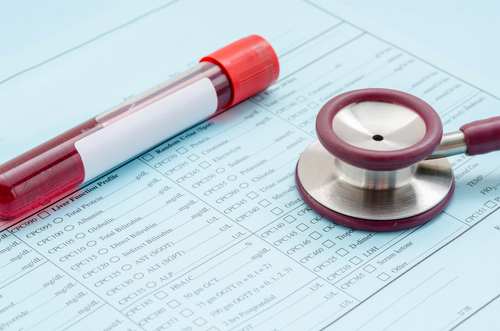IGFBP2 Protein May Be New Biomarker for PAH, Study Suggests

Elevated levels of the protein IGFBP2 were identified in the blood of people with pulmonary arterial hypertension (PAH) and found to be associated with lower physical function, higher arterial blood pressure, and an increased mortality risk, a study reports.
These findings support evaluating IGFBP2 as a biomarker for PAH to assist in diagnosing and monitoring disease progression, the researchers say.
The study, “Insulin-like growth factor binding protein-2: a new circulating indicator of pulmonary arterial hypertension severity and survival,” was published in the journal BMC Medicine.
PAH is characterized by the narrowing of the pulmonary arteries, the blood vessels that transport blood through the lungs, restricting blood flow and causing high blood pressure, which makes the heart work harder.
The primary method to diagnose PAH is an invasive technique known as right heart catheterization, in which a flexible tube (catheter) is threaded into the right side of the heart and into the pulmonary arteries to measure pulmonary artery pressure.
A blood test for NTproBNP, a standard marker for cardiac stress, can help diagnose PAH, but this test is influenced by heart disease and kidney function. As such, a precise, disease-related biomarker is needed to allow a non-invasive diagnosis and to help monitor disease progression.
A previous study found high levels of a protein called insulin-like growth factor binding protein 2 (IGFBP2) in the blood of PAH patients, as compared with healthy controls.
Now, researchers at Johns Hopkins University in Baltimore evaluated whether IGFBP2 could be used as a diagnostic biomarker for PAH by testing two independent groups (cohorts) of people with the disease and comparing the results with a healthy control group.
“We investigated the diagnostic and prognostic value of serum IGFBP2 in PAH to determine if it could discriminate PAH from healthy controls and if it was associated with disease severity and survival,” the researchers wrote.
The first group consisted of 127 adults with PAH enrolled in the Johns Hopkins Pulmonary Hypertension (JHPH) program; these patients had a median age of 62, and 84% were women. A total of 128 volunteers, with a median age of 43 and including 96 women (75%), were part of the healthy control group.
The concentration of IGFBP2 in the blood of these PAH patients was significantly higher compared with the controls — median 350.9 nanograms (ng)/ml vs. 170.2 ng/ml in the control group.
The 203 PAH patients in the second group had samples in the National Biological Sample and Data Repository for Pulmonary Arterial Hypertension (PAH Biobank, PAHB). The median age of this group was 56, and 78% were women.
Similarly to the JHPH group, the levels of IGFBP2 were significantly increased in the PAHB group compared with the healthy controls — median 474.6 vs. 170.2 ng/ml.
A statistical analysis found that IGFBP2 levels discriminated patients with PAH in the JHPH group from healthy controls with a cutoff value of 262.8 ng/ml. This cutoff had a sensitivity (true positive rate) for PAH of 62.2% and a specificity (true negative rate) of 78.5%.
Testing this cutoff value in the PAHB group and among controls showed that it performed well in discriminating PAH, with a sensitivity of 84% to correctly predict PAH and a specificity of 79% to accurately predict no PAH (no disease).
The likelihood ratio for PAH in a person with IGFBP2 levels below 262.8 ng/ml was 0.2, while for those with values of 262.8 ng/ml or greater, the likelihood ratio for PAH was 3.9 times higher.
A significant negative correlation was found between IGFBP2 levels and the distanced walked in six minutes (6MWD; a measure of exercise capacity) in both patient groups, in which higher IGFBP2 levels were associated with less distance walked.
After adjusting the results for age and sex, each log-unit increase of IGFBP2 was associated with a 50-meter (about 164 feet) decrease in 6MWD in the JHPH group and a 57-meter (187-foot) decrease among the PAHB patients. Among the JHPH group, there also was an increase of 9-mmHg in mean pulmonary arterial blood pressure.
IGFBP2 levels above the median value were significantly associated with a 2.97 times increased risk of death in the JHPH cohort. Similar results were found in the PAHB cohort, with a 3.95 times higher mortality risk.
A statistical analysis taking into account several factors — including age, sex, functional class, PAH type, blood flow parameters, and 6MWD scores — revealed that higher levels of IGFBP2 were a significant independent predictor of mortality only in the PAHB group.
Apart from blood levels, the researchers also analyzed the IGFBP2 protein levels in lung tissue samples from four PAH patients and four controls. The results showed that IGFBP2 levels were significantly higher in the PAH patients’ tissue than in the healthy individuals.
To test whether pulmonary arterial cells are a source of IGFBP2 in the lung, primary small pulmonary artery smooth muscle cells (PASMC) and endothelial cells (PAEC) were isolated from pulmonary arteries of patients with severe PAH or donor’s lungs.
The gene activity (expression) that encodes for IGFBP2 protein was significantly higher in PASMC than PAEC but not between PAH and controls. Moreover, IGFBP2 was secreted from both PAEC and PASMC, but their level was significantly higher in PASMC.
“IGFBP2 is a potential new circulating PAH biomarker associated with disease severity and survival and provides valuable clinical prognostic information,” the researchers wrote. “The increased expression of IGFBP2 in PAH lung and PASMC suggests that IGFBP2 could have a direct role in pulmonary pathobiology of PAH.”
The team suggested that further studies are needed to better understand this new pathway involving IGFBP2 and to investigate its possible utility for PAH clinical care.







